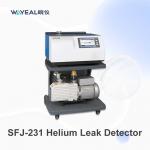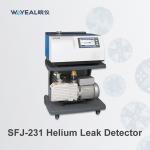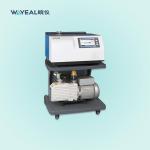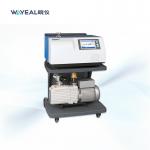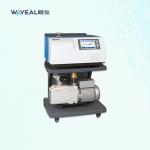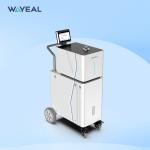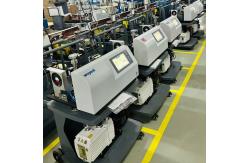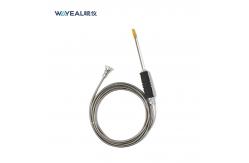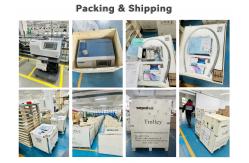1500Pa Sniffer Helium Leak Detection Equipment for Power Industry
Technical Parameters of SFJ-231 Helium Leak Detector
| Minimum detectable leak rate(Pa·m³/s)/ vacuum mode | 5.0*10-13 P·m3/s |
| Minimum detectable leak rate(Pa·m³/s)/ sniffer mode | 5.0*10-9 P·m3/s |
| Maximum allowable leak detection pressure (Pa) | 1500 |
| Response time | <1s |
| Startup time | ≤2min |
| Detectable quality | 2, 3,4(H2 ,He3, He4) |
| Man-machine interface | 7" color LCD touch screen |
| Ion source | 2pcs, iridium coated yttrium oxide, automatic switching |
| I/O Input/output interface | 8 inputs and 8 outputs |
| Communication interface | RS232/485, USB*2 |
| MES interface | standard |
| Leak Detection port | DN25KF |
| Power Supply | AC220V, 50Hz/60Hz |
| Operating temperature | 0~40°C |
| Language | English |
| Leakage rate display | Figure, bar chart, curve chart |
| Diamension | 645*678*965mm |
Application of SFJ-231 Helium Mass Spectrometer Leak Detector in
High-Voltage GIS Equipment / SF₆ Gas Tightness Testing in the Power
Industry
Helium mass spectrometry leak detection is a core method for GIS
sealing tests due to helium’s (He) small molecular size, high
permeability, non-reactivity with SF₆, and the ultra-high
sensitivity of the SFJ-231 leak detector (minimum detectable leak
rate: 5.0×10⁻¹³ Pa・m³/s in vacuum mode). By using helium as a
tracer gas, the detector captures helium signals to locate leaks
and quantify leak rates.
The SFJ-231 supports vacuum mode (higher sensitivity) and sniffer
mode (convenient for pressurized systems, max allowable pressure:
1500 Pa). For GIS equipment, sniffer method can be used below:
Sniffer Mode Leak Detection (For Pressurized GIS, On-Site
Convenience)
Application: Operational GIS (internally pressurized with SF₆, but pressure
must be ≤1500 Pa; if higher, reduce pressure first).
Principle: Inject a small amount of helium (mixed with SF₆, without affecting
the insulation performance) into the GIS equipment, use the spary
gun of SFJ-231 (connected through I/O interface) to get close to
the suspicious point, if there is a leak, the helium will leak
along with the SF₆, which will be captured by the spray gun and
transmitted to the leak detector to realize the leakage rate
detection.
Technical suitability: The minimum leak rate of 5.0×10-⁹ Pa・m³/s in sniffer mode and a response time of <1s make
it possible to quickly locate leaks, which makes it suitable for
rapid on-site inspections.
Steps of Leak Detection in Suction Gun Mode (GIS equipment with
pressure)
1. Tracer Gas Injection
Inject helium gas into the GIS equipment: through the filling port
of the equipment, inject pure helium according to 1% to 5% of the
volume of SF₆ (make sure that the mixture is uniform, and leave it
for more than 30min, so as to make helium gas diffuse to all the
chambers).
2. Sniffer connection and parameter setting
Connect the sniffer to SFJ-231 via I/O connector (8 inputs and 8
outputs), switch to “Sniffer Mode” in the touch panel, set the
sniffer flow rate (default value, or adjust it according to the
site), and the leakage rate alarm threshold.
3. Sniffer detection
Hold the sniffer in hand, close to the suspicious point (distance
1-3mm), move slowly (speed ≤5cm/s), make sure to cover the whole
sealing surface.
If the leak detector shows that the leakage rate exceeds the
threshold (e.g. 5.0×10-⁹ Pa・m³/s), mark the point as a leakage point and record the
leakage rate and location.
4. Quantitative testing
Stabilize the sniffer against the leakage point for 10s, take the
average leakage rate as the final result.
